Chlorine-Functional Silsesquioxanes (POSS-Cl) as Effective Flame Retardants and Reinforcing Additives for Rigid Polyurethane Foams
Abstract
:1. Introduction
2. Results and Discussion
2.1. The Impact of POSS-Cl on Polyol Viscosity and Processing Parameters of Polyol Premixes
2.2. The Impact of POSS-Cl on Morphology and Apparent Density PUR Foams
2.3. Mechanical Properties of PUR Foams
2.4. Hydrophobic Properties of PUR Foams
2.5. Thermal Stability and Fire Behavior of PUR Foams
3. Materials and Methods
3.1. Materials
3.2. Synthesis of PUR Composites Foams
3.3. Methods and Instruments
4. Conclusions
Author Contributions
Funding
Institutional Review Board Statement
Informed Consent Statement
Data Availability Statement
Conflicts of Interest
References
- Gama, N.V.; Ferreira, A.; Barros-Timmons, A. Polyurethane foams: Past, present, and future. Materials 2018, 11, 1841. [Google Scholar] [CrossRef] [Green Version]
- Szycher, M. Szycher’s Handbook of Polyurethanes, 2nd ed.; CRC Press: New York, NY, USA, 2006. [Google Scholar]
- Engels, H.W.; Pirkl, H.G.; Albers, R.; Albach, R.W.; Krause, J.; Hoffmann, A.; Casselmann, H.; Dormish, J. Polyurethanes: Versatile materials and sustainable problem solvers for today’s challenges. Angew. Chem. Int. Ed. 2013, 52, 9422–9441. [Google Scholar] [CrossRef]
- Joshi, M.; Adak, B.; Butola, B.S. Polyurethane nanocomposite based gas barrier films, membranes and coatings: A review on synthesis, characterization and potential applications. Prog. Mater. Sci. 2018, 97, 230–282. [Google Scholar] [CrossRef]
- Zhang, G.; Lin, X.; Zhang, Q.; Jiang, K.; Chen, W.; Han, D. Anti-flammability, mechanical and thermal properties of bio-based rigid polyurethane foams with the addition of flame retardants. RSC Adv. 2020, 10, 32156–32161. [Google Scholar] [CrossRef]
- Kurańska, M.; Polaczek, K.; Auguścik-Królikowska, M.; Prociak, A.; Ryszkowska, J. Open-cell rigid polyurethane bio-foams based on modified used cooking oil. Polymer 2020, 190, 1–7. [Google Scholar] [CrossRef]
- Członka, S.; Strakowska, A.; Strzelec, K.; Adamus-Włodarczyk, A.; Kairyte, A.; Vaitkus, S. Composites of rigid polyurethane foams reinforced with POSS. Polymers 2019, 11, 336. [Google Scholar] [CrossRef] [PubMed] [Green Version]
- Wang, S.X.; Zhao, H.B.; Rao, W.H.; Huang, S.C.; Wang, T.; Liao, W.; Wang, Y.Z. Inherently flame-retardant rigid polyurethane foams with excellent thermal insulation and mechanical properties. Polymer 2018, 153, 616–625. [Google Scholar] [CrossRef]
- Lee, J.; Jung, I. Tuning sound absorbing properties of open cell polyurethane foam by impregnating graphene oxide. Appl. Acoust. 2019, 151, 10–21. [Google Scholar] [CrossRef]
- Kaur, R.; Kumar, M. Addition of anti-flaming agents in castor oil based rigid polyurethane foams: Studies on mechanical and flammable behaviour. Mater. Res. Express 2020, 7. [Google Scholar] [CrossRef]
- Jiao, L.; Xiao, H.; Wang, Q.; Sun, J. Thermal degradation characteristics of rigid polyurethane foam and the volatile products analysis with TG-FTIR-MS. Polym. Degrad. Stab. 2013, 98. [Google Scholar] [CrossRef]
- Strąkowska, A.; Członka, S.; Konca, P.; Strzelec, K. New flame retardant systems based on expanded graphite for rigid polyurethane foams. Appl. Sci. 2020, 10, 5817. [Google Scholar] [CrossRef]
- Xu, W.; Wang, G.; Zheng, X. Research on highly flame-retardant rigid PU foams by combination of nanostructured additives and phosphorus flame retardants. Polym. Degrad. Stab. 2015, 111, 142–150. [Google Scholar] [CrossRef]
- Ye, L.; Meng, X.-Y.; Liu, X.-M.; Tang, J.-H.; Li, Z.-M. Flame-Retardant and Mechanical Properties of High-Density Rigid Polyurethane Foams Filled with Decabrominated Dipheny Ethane and Expandable Graphite. J. Appl. Polym. Sci. 2009, 111, 2373–2380. [Google Scholar] [CrossRef]
- Thirumal, M.; Khastgir, D.; Nando, G.B.; Naik, Y.P.; Singha, N.K. Halogen-free flame retardant PUF: Effect of melamine compounds on mechanical, thermal and flame retardant properties. Polym. Degrad. Stab. 2010, 95, 1138–1145. [Google Scholar] [CrossRef]
- Shi, L.; Li, Z.-M.; Xie, B.-H.; Wang, J.-H.; Tian, C.-R.; Yang, M.-B. Flame retardancy of different-sized expandable graphite particles for high-density rigid polyurethane foams. Polym. Int. 2006, 55, 862–871. [Google Scholar] [CrossRef]
- Lindholm, J.; Brink, A.; Wilen, C.-E.; Hupa, M. Cone Calorimeter Study of Inorganic Salts as Flame Retardants in Polyurethane Adhesive with Limestone Filler. J. Appl. Polym. Sci. 2012, 123, 1793–1800. [Google Scholar] [CrossRef]
- Chen, L.; Wang, Y.Z. A review on flame retardant technology in China. Part I: Development of flame retardants. Polym. Adv. Technol. 2010, 21, 1–26. [Google Scholar] [CrossRef]
- Zhao, P.; Guo, C.; Li, L. Exploring the effect of melamine pyrophosphate and aluminum hypophosphite on flame retardant wood flour/polypropylene composites. Constr. Build. Mater. 2018, 170, 193–199. [Google Scholar] [CrossRef]
- Fanglong, Z.; Qun, X.; Qianqian, F.; Rangtong, L.; Kejing, L. Influence of nano-silica on flame resistance behavior of intumescent flame retardant cellulosic textiles: Remarkable synergistic effect? Surf. Coat. Technol. 2016, 294, 90–94. [Google Scholar] [CrossRef]
- Ai, L.; Chen, S.; Zeng, J.; Yang, L.; Liu, P. Synergistic Flame Retardant Effect of an Intumescent Flame Retardant Containing Boron and Magnesium Hydroxide. ACS Omega 2019, 4, 3314–3321. [Google Scholar] [CrossRef]
- Zhou, F.; Zhang, T.; Zou, B.; Hu, W.; Wang, B.; Zhan, J.; Ma, C.; Hu, Y. Synthesis of a novel liquid phosphorus-containing flame retardant for flexible polyurethane foam: Combustion behaviors and thermal properties. Polym. Degrad. Stab. 2020, 171, 109029. [Google Scholar] [CrossRef]
- Hebda, E.; Ozimek, J.; Raftopoulos, K.N.; Michałowski, S.; Pielichowski, J.; Jancia, M.; Pielichowski, K. Synthesis and morphology of rigid polyurethane foams with POSS as pendant groups or chemical crosslinks. Polym. Adv. Technol. 2015, 26, 932–940. [Google Scholar] [CrossRef]
- Fina, A.; Tabuani, D.; Frache, A.; Camino, G. Polypropylene-polyhedral oligomeric silsesquioxanes (POSS) nanocomposites. Polymer 2005, 46, 7855–7866. [Google Scholar] [CrossRef]
- Shi, H.; Yang, J.; You, M.; Li, Z.; He, C. Polyhedral Oligomeric Silsesquioxanes (POSS)-Based Hybrid Soft Gels: Molecular Design, Material Advantages, and Emerging Applications. ACS Mater. Lett. 2020, 2, 296–316. [Google Scholar] [CrossRef]
- Zatorski, W.; Sałasinska, K. Combustibility studies of unsaturated polyester resins modified by nanoparticles. Polimery 2016, 61, 815–823. [Google Scholar] [CrossRef]
- Fina, A.; Abbenhuis, H.C.L.; Tabuani, D.; Camino, G. Metal functionalized POSS as fire retardants in polypropylene. Polym. Degrad. Stab. 2006, 91, 2275–2281. [Google Scholar] [CrossRef]
- Gentiluomo, S.; Veca, A.D.; Monti, M.; Zaccone, M.; Zanetti, M. Fire behavior of polyamide 12 nanocomposites containing POSS and CNT. Polym. Degrad. Stab. 2016, 134, 151–156. [Google Scholar] [CrossRef]
- Janowski, B.; Pielichowski, K. Thermo(oxidative) stability of novel polyurethane/POSS nanohybrid elastomers. Thermochim. Acta 2008, 478, 51–53. [Google Scholar] [CrossRef]
- Zhang, W.; Camino, G.; Yang, R. Polymer/polyhedral oligomeric silsesquioxane (POSS)nanocomposites: An overview of fire retardance. Prog. Polym. Sci. 2017, 67, 77–125. [Google Scholar] [CrossRef]
- Fan, X.; Cao, M.; Zhang, X.; Li, Z. Synthesis of star-like hybrid POSS-(PDMAEMA-b-PDLA)8 copolymer and its stereocomplex properties with PLLA. Mater. Sci. Eng. C 2017, 76, 211–216. [Google Scholar] [CrossRef] [PubMed]
- Laoutid, F.; Bonnaud, L.; Alexandre, M.; Lopez-Cuesta, J.M.; Dubois, P. New prospects in flame retardant polymer materials: From fundamentals to nanocomposites. Mater. Sci. Eng. R Rep. 2009, 63, 100–125. [Google Scholar] [CrossRef]
- Ye, X.; Zhang, W.; Yang, R.; He, J.; Li, J.; Zhao, F. Facile synthesis of lithium containing polyhedral oligomeric phenyl silsesquioxane and its superior performance in transparency, smoke suppression and flame retardancy of epoxy resin. Compos. Sci. Technol. 2020, 189, 108004. [Google Scholar] [CrossRef]
- Marcinkowska, A.; Przadka, D.; Dudziec, B.; Szczesniak, K.; Andrzejewska, E. Anchor effect in polymerization kinetics: Case of monofunctionalized POSS. Polymers 2019, 11, 515. [Google Scholar] [CrossRef] [PubMed] [Green Version]
- Sałasińska, K.; Leszczyńska, M.; Celiński, M.; Kozikowski, P.; Kowiorski, K.; Lipińska, L. Burning Behaviour of Rigid Polyurethane Foams with Histidine and Modified Graphene Oxide. Materials 2021, 14, 1184. [Google Scholar] [CrossRef] [PubMed]
- Członka, S.; Strąkowska, A.; Kairytė, A.; Kremensas, A. Nutmeg filler as a natural compound for the production of polyurethane composite foams with antibacterial and anti-aging properties. Polym. Test. 2020, 86, 106479. [Google Scholar] [CrossRef]
- Estravísa, S.; Tirado-Mediavillaa, J.; Santiago-Calvoa, M.; Ruiz-Herreroa, J.L.; Villafañeb, F.; Rodríguez-Pérez, M.A. Rigid polyurethane foams with infused nanoclays: Relationship between cellular structure and thermal conductivity. Eur. Polym. J. 2016, 80, 1–15. [Google Scholar] [CrossRef] [Green Version]
- Strąkowska, A.; Kosmalska, A.; Zaborski, M. Surface modification of methylvinylsilicone rubber vulcanizates with polyhedral oligomeric silsesquioxanes functionalized using chloride groups (POSS-Cl). Polimery 2016, 61, 272–278. [Google Scholar] [CrossRef]
- Septevani, A.A.; Evans, D.A.C.; Chaleat, C.; Martin, D.J.; Annamalai, P.K. A systematic study substituting polyether polyol with palm kernel oil based polyester polyol in rigid polyurethane foam. Ind. Crops Prod. 2015, 66. [Google Scholar] [CrossRef]
- Acuña, P.; Li, Z.; Santiago-Calvo, M.; Villafañe, F.; Rodríguez-Perez, M.Á.; Wang, D.-Y. Influence of the characteristics of expandable graphite on the morphology, thermal properties, fire behaviour and compression performance of a rigid polyurethane foam. Polymers 2019, 11, 168. [Google Scholar] [CrossRef] [Green Version]
- Chattopadhyay, D.; Webster, D.C. Thermal stability and flame retardancy of polyurethanes. Prog. Polym. Sci. 2009, 34, 1068–1133. [Google Scholar] [CrossRef]
- Chua, M.H.; Zhou, H.; Xu, J. POSS as Fire Retardant: Preparation, Properties, Applications. In Polymer/POSS Nanocomposites and Hybrid Materials; Springer: Berlin, Germany, 2018; pp. 337–372. [Google Scholar] [CrossRef]
- Szatylowicz, H.; Jezuita, A.; Krygowski, T.M. On the relations between aromaticity and substituent effect. Struct. Chem. 2019, 30, 1529–1548. [Google Scholar] [CrossRef] [Green Version]

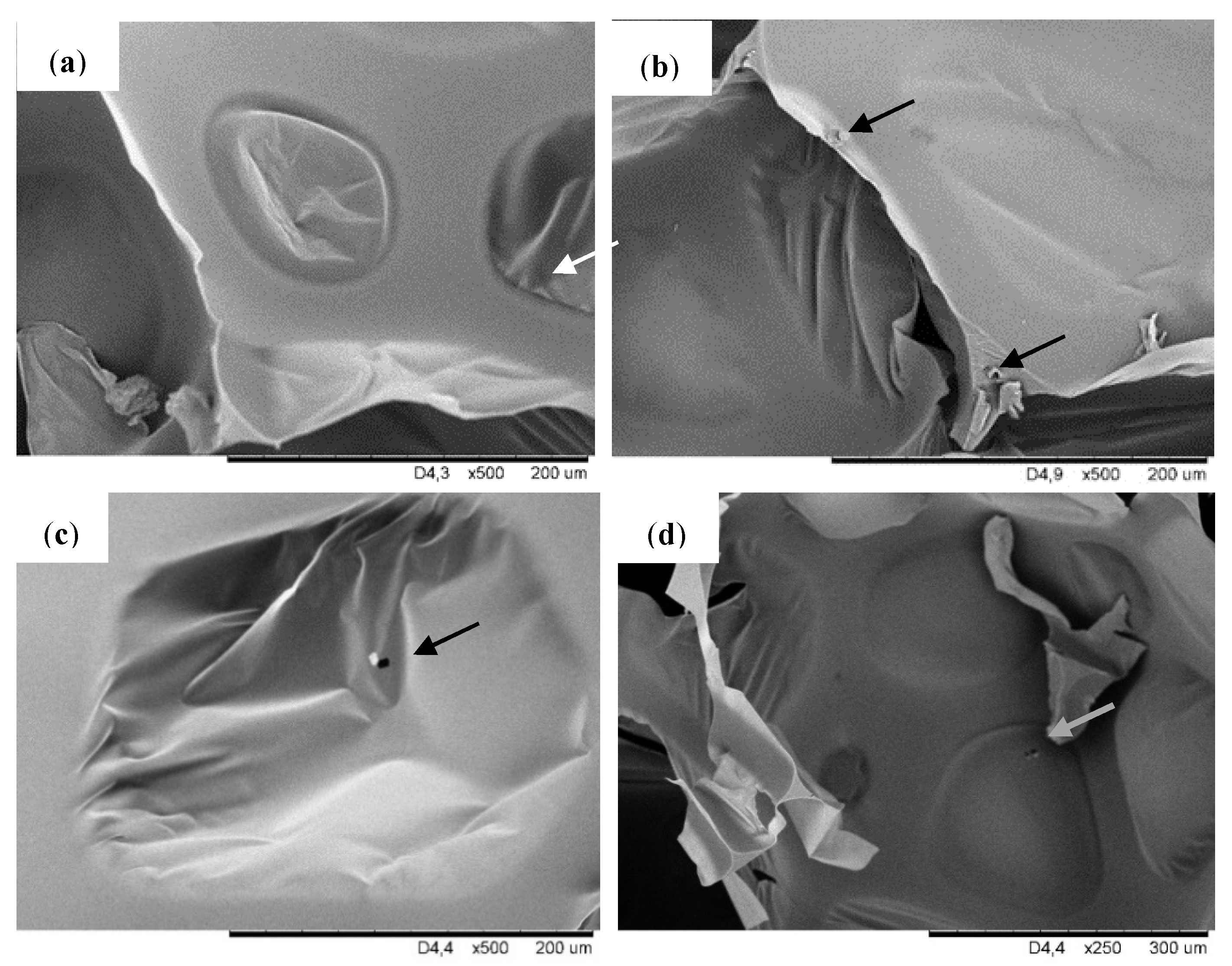

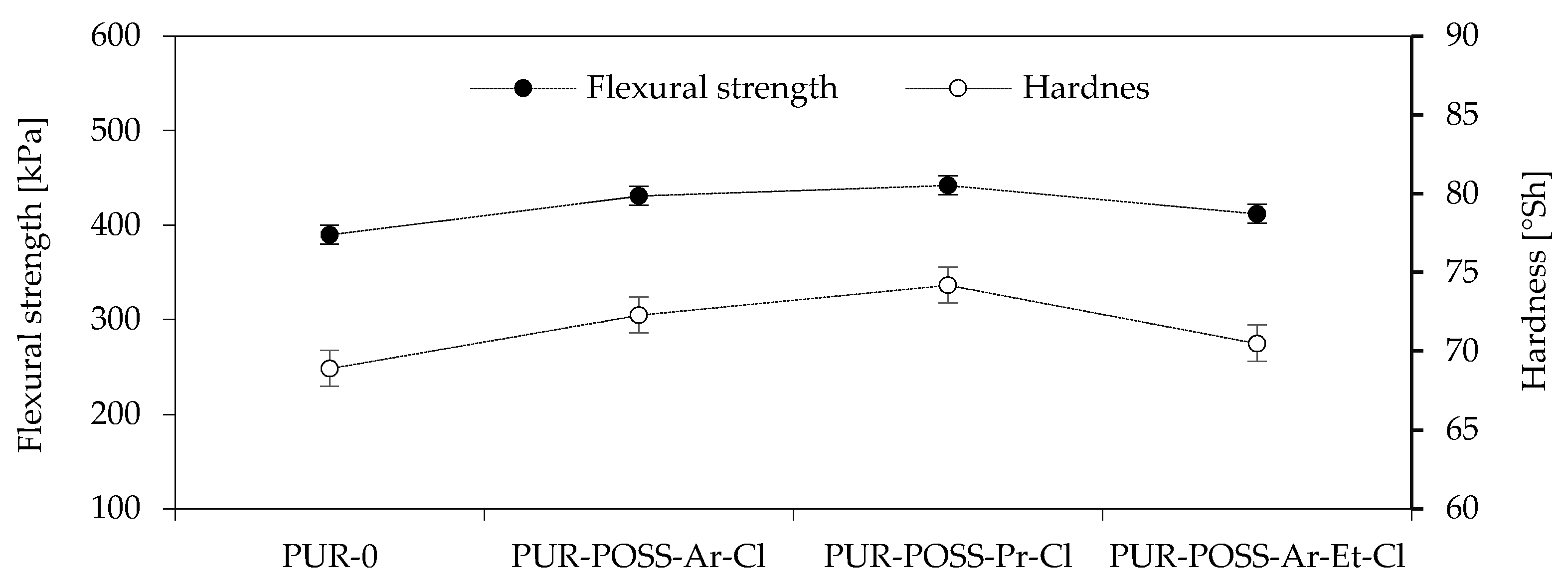
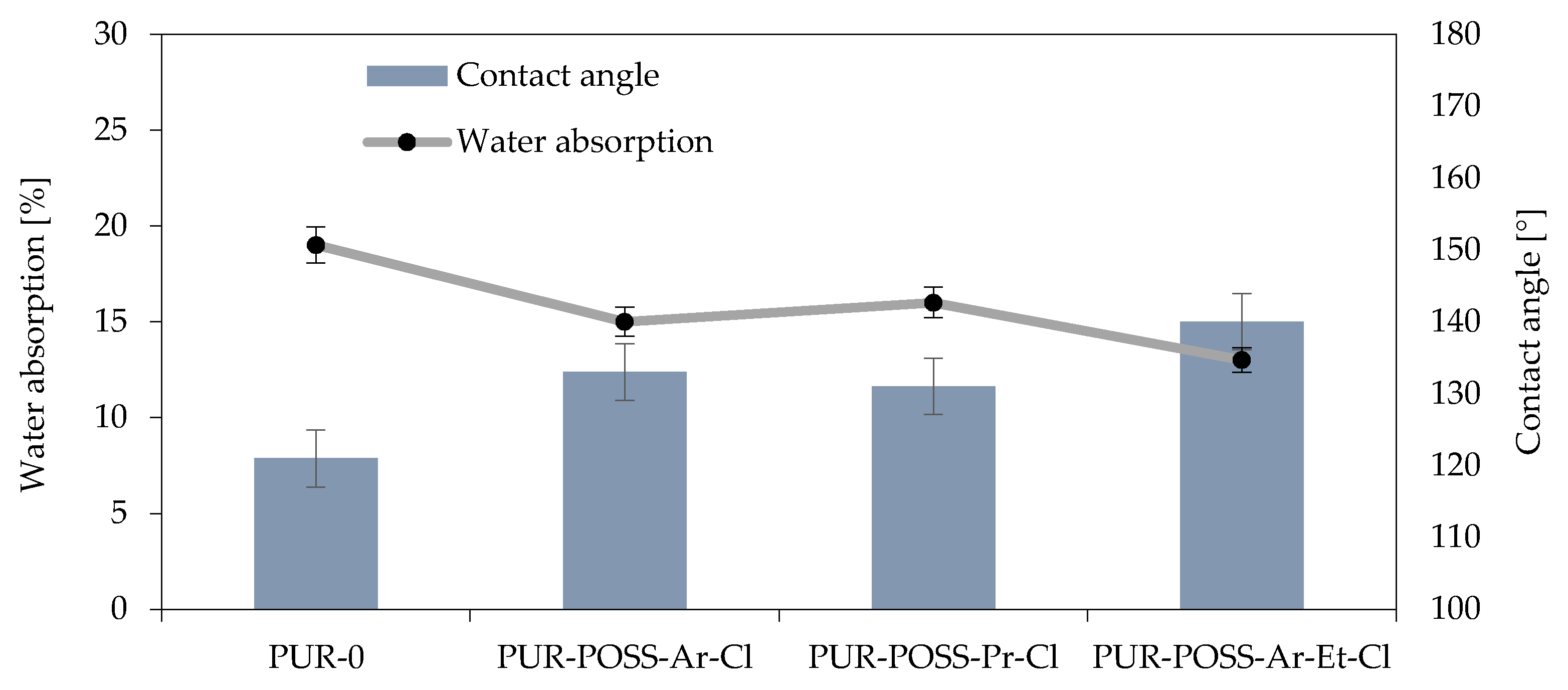
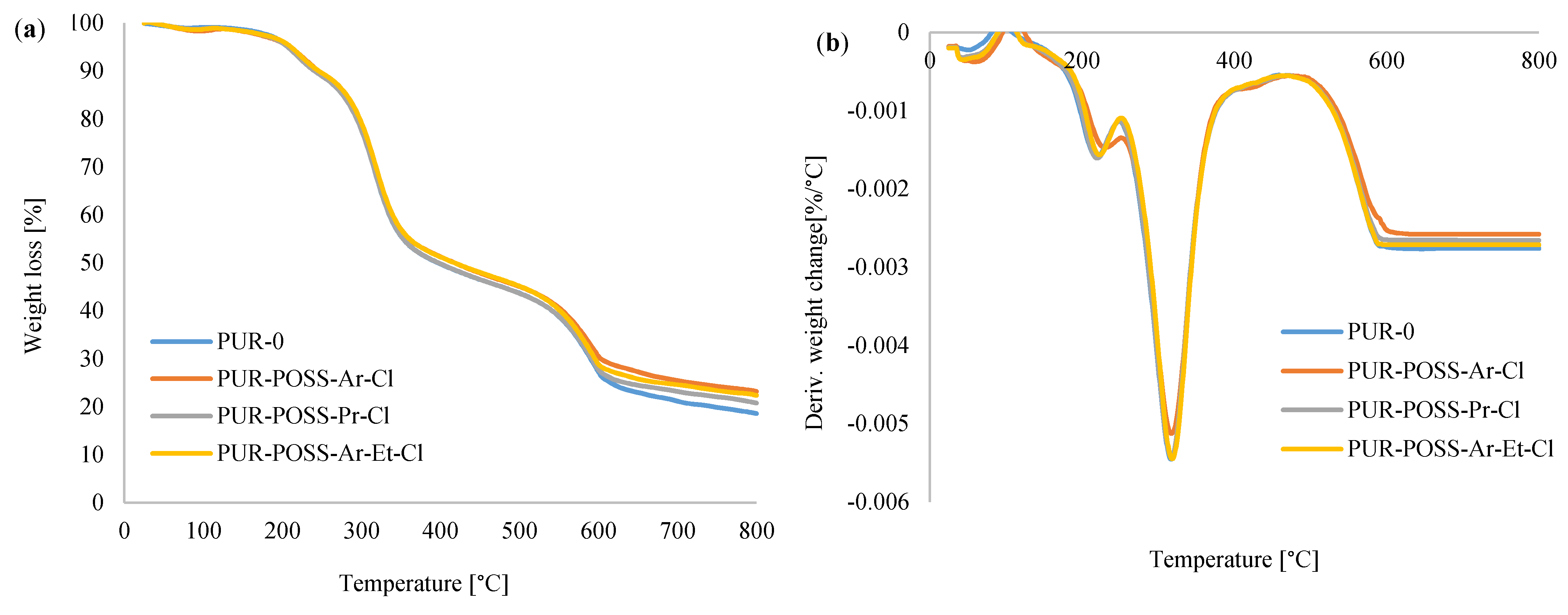
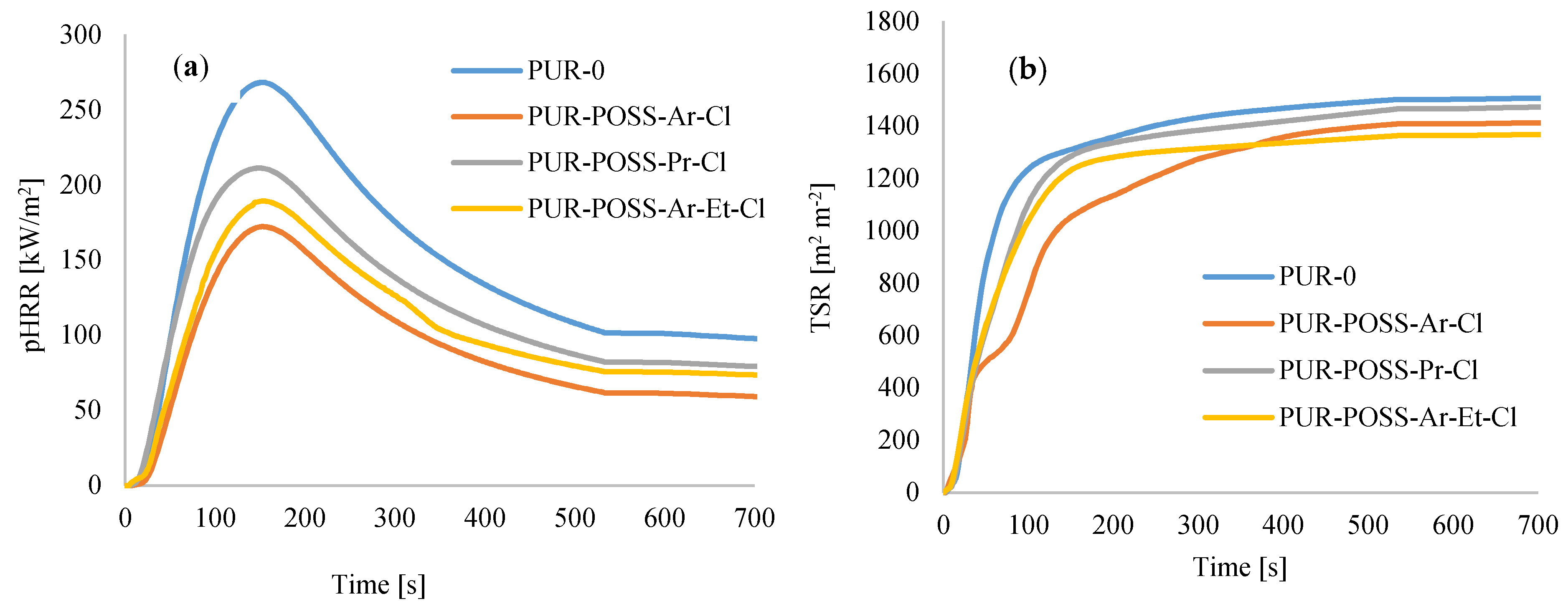
| Sample Code | Dynamic Viscosity η [mPa·s] | TMax [°C] | Processing Times [s] | ||||
|---|---|---|---|---|---|---|---|
| 0.5 RPM | 50 RPM | 100 RPM | Cream Time | Growth Time | Tack-Free Time | ||
| PUR-0 | 840 ± 9 | 430 ± 7 | 320 ± 8 | 118.2 ± 4 | 40 ± 2 | 270 ± 9 | 365 ± 9 |
| PUR-POSS-Ar-Cl | 1120 ± 10 | 930 ± 9 | 440 ± 10 | 135.7 ± 5 | 47 ± 1 | 260 ± 11 | 325 ± 9 |
| PUR-POSS-Pr-Cl | 1090 ± 10 | 870 ± 10 | 420 ± 11 | 138.2 ± 4 | 45 ± 2 | 215 ± 10 | 298 ± 12 |
| PUR-POSS-Ar-Et-Cl | 1210 ± 10 | 960 ± 11 | 470 ± 12 | 141.2 ± 6 | 48 ± 2 | 230 ± 9 | 314 ± 8 |
| Sample Code | Cell Size [µm] | Wall Thickness [µm] | Apparent Density [kg m−3] |
|---|---|---|---|
| PUR-0 | 475 ± 10 | 63 ± 4 | 39 ± 1 |
| PUR-POSS-Ar-Cl | 442 ± 8 | 68 ± 5 | 42 ± 2 |
| PUR-POSS-Pr-Cl | 421 ± 9 | 67 ± 2 | 43 ± 2 |
| PUR-POSS-Ar-Et-Cl | 413 ± 12 | 69 ± 3 | 41 ± 2 |
| Sample Code | T5 [°C] | T10 [°C] | T50 [°C] | T70 [°C] | Char Residue [%] |
|---|---|---|---|---|---|
| PUR-0 | 209 | 241 | 397 | 589 | 18.6 |
| PUR-POSS-Ar-Cl | 211 | 247 | 419 | 605 | 23.2 |
| PUR-POSS-Pr-Cl | 207 | 241 | 399 | 593 | 20.8 |
| PUR-POSS-Ar-Et-Cl | 211 | 245 | 417 | 597 | 22.4 |
| Sample Code | TTI (s) | pHRR (kW/m2) | THR (MJ/m2) | MAHRE (kW/m2) | TSR (m2/m2) | Char Residue [%] |
|---|---|---|---|---|---|---|
| PUR-0 | 2 (0) | 268 (8) | 21.4 (1) | 168 (8) | 1490 | 18.9 (3) |
| PUR-POSS-Ar-Cl | 5 (1) | 172 (11) | 20.2 (2) | 128 (13) | 1411 | 21.4 (5) |
| PUR-POSS-Pr-Cl | 4 (0) | 211 (13) | 20.6 (2) | 153 (16) | 1472 | 19.6 (4) |
| PUR-POSS-Ar-Et-Cl | 4 (0) | 189 (13) | 20.5 (3) | 139 (11) | 1367 | 18.2 (4) |
| Coumpound | Abbreviation in the Text | Structure | Summary Formula |
|---|---|---|---|
| Chlorobenzyllsobutyl POSS | POSS-Ar-Cl |  | [C35H69ClO12Si8] |
| Chloropropyllsobutyl POSS | POSS-Pr-Cl |  | [C31H69ClO12Si8] |
| Chlorobenzylethyllsobutyl POSS | POSS-Ar-Et-Cl | 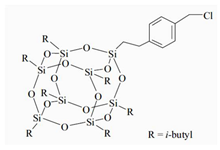 | [C37H73ClO12Si8] |
Publisher’s Note: MDPI stays neutral with regard to jurisdictional claims in published maps and institutional affiliations. |
© 2021 by the authors. Licensee MDPI, Basel, Switzerland. This article is an open access article distributed under the terms and conditions of the Creative Commons Attribution (CC BY) license (https://creativecommons.org/licenses/by/4.0/).
Share and Cite
Strąkowska, A.; Członka, S.; Miedzińska, K.; Strzelec, K. Chlorine-Functional Silsesquioxanes (POSS-Cl) as Effective Flame Retardants and Reinforcing Additives for Rigid Polyurethane Foams. Molecules 2021, 26, 3979. https://doi.org/10.3390/molecules26133979
Strąkowska A, Członka S, Miedzińska K, Strzelec K. Chlorine-Functional Silsesquioxanes (POSS-Cl) as Effective Flame Retardants and Reinforcing Additives for Rigid Polyurethane Foams. Molecules. 2021; 26(13):3979. https://doi.org/10.3390/molecules26133979
Chicago/Turabian StyleStrąkowska, Anna, Sylwia Członka, Karolina Miedzińska, and Krzysztof Strzelec. 2021. "Chlorine-Functional Silsesquioxanes (POSS-Cl) as Effective Flame Retardants and Reinforcing Additives for Rigid Polyurethane Foams" Molecules 26, no. 13: 3979. https://doi.org/10.3390/molecules26133979
APA StyleStrąkowska, A., Członka, S., Miedzińska, K., & Strzelec, K. (2021). Chlorine-Functional Silsesquioxanes (POSS-Cl) as Effective Flame Retardants and Reinforcing Additives for Rigid Polyurethane Foams. Molecules, 26(13), 3979. https://doi.org/10.3390/molecules26133979







